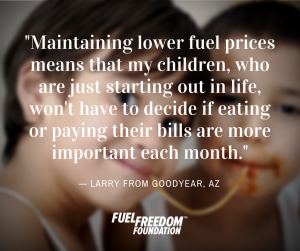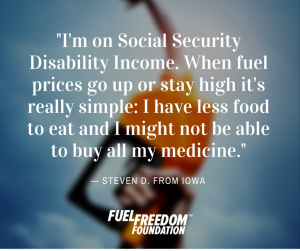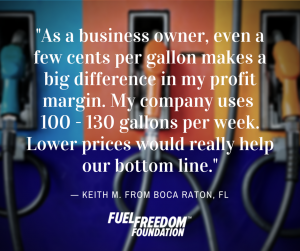Missouri dad perfectly sums up the frustration of volatile gas prices
Recently we started asking Americans to share their stories about the true cost of unpredictable gas prices. We got an earful.
But out of all the dozens of submissions we received — some only a sentence, others full-on essays — perhaps no one expressed that collective frustration better than Troy Harper of Independence, Missouri.
Here’s what he wrote:
“I used to have a pickup truck [a green 1981 Ford F-series Explorer] with dual tanks. I could usually fill it up for about 30 bucks. That was back when I was in my early 20s, somewhere in 1993 or ‘94. I can remember complaining about the gas prices then. Oh, if only could only go back and warn myself about what was gonna take place in my future, I’d sink every penny I had into crude oil. Because from there on, fuel prices continually increased! Before long it was 3 bucks a gallon and beyond that. It never hit $4 a gallon for regular, but if you wanted mid-grade or super-clean, you were basically paying in blood.
“I got married and had a family, 1996-’97. We had two kids about four years apart. I worked a full-time job had to get a car in order to get around and get back and forth to work. We went on vacations and went to see our families and camped out and went fishing and to the drive-in theater all the time, when we could. But as fuel prices got higher and higher, those trips became fewer and fewer. With the price of fuel rising, the price of everything else rises: food, clothing, household necessities, everything.
“I drove a truck for a produce company [Original DeFeo Produce], locally … I delivered fruits and vegetables to grocery stores and restaurants. Diesel prices were ridiculous. The prices of our products were forever increasing, a fuel surcharge was eventually imposed on our customers, just to cover fuel prices. At almost 5 bucks a gallon it was becoming a huge problem. Our customers’ businesses were seeing less and less business, yet the prices kept increasing. I watched several of these businesses eventually close their doors for good. Even the company I was working for went out of business in March of 2013. It had been in business in downtown Kansas City, Missouri, for over a hundred years. It was family owned and had thrived for a long time, but with the economy bottoming out and our customers closing, it was inevitable. I like to believe that fuel prices played a major role in that factor. As it did in all our lives.
“Currently, the prices have been relatively cheaper. As of today, at a Shell station I saw it for $2.20 a gallon in Independence, Missouri. That’s much better, but I don’t know how long those prices will last.”
—
To learn what you can do about volatile gasoline prices, check out our Take Action page. Among the list of choices, watch the movie PUMP on DVD, instantly on iTunes or Amazon, or coming to a college




